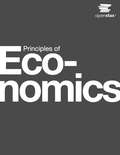Special Collections
Free Upskilling Books for All!
- Table View
- List View
Precalculus
by OpenStaxPrecalculus is intended for college-level Precalculus students. Since Precalculus courses vary from one institution to the next, we have attempted to meet the needs of as broad an audience as possible, including all of the content that might be covered in any particular course. The result is a comprehensive book that covers more ground than an instructor could likely cover in a typical one- or two-semester course; but instructors should find, almost without fail, that the topics they wish to include in their syllabus are covered in the text. Many chapters of Openstax Precalculus are suitable for other freshman and sophomore math courses such as College Algebra and Trigonometry; however, instructors of those courses might need to supplement or adjust the material. Openstax will also be releasing a College Algebra and Trigonometry title tailored to the particular scope, sequence, and pedagogy of those courses.
Principles of Economics
by OpenStaxPrinciples of Economics covers the scope and sequence for a two-semester principles of economics course. The text also includes many current examples, including; discussions on the great recession, the controversy among economists over the Affordable Care Act (Obamacare), the recent government shutdown, and the appointment of the United States’ first female Federal Reserve chair, Janet Yellen. The pedagogical choices, chapter arrangements, and learning objective fulfillment were developed and vetted with feedback from educators dedicated to the project. The outcome is a balanced approach to micro and macro economics, to both Keynesian and classical views, and to the theory and application of economics concepts. Current events are treated in a politically-balanced way, as well.
American Government and Politics in the Information Age
by David L. Paletz and Diana Owen and Timothy E. CookAmerican Government and Politics in the Information Age by Paletz, Owen, and Cook, is a comprehensive introduction to the vital subject of American government and politics. It is a comprehensive introduction to American politics and government; it covers all the basics. The text: * introduces the intricacies of the Constitution, the complexities of federalism, the meanings of civil liberties, and the conflicts over civil rights; * explains how people are socialized to politics, acquire and express opinions, and participate in political life; * describes interest groups, political parties, and elections--the intermediaries that link people to government and politics; * details the branches of government and how they operate; * shows how policies are made and affect people's lives.
An Introduction to Politics
by T. M. SellThis textbook introduces students to the field of Political Studies. An Introduction to Politics is a little more brief, concise and in-between than similar textbooks currently on the market. Because this is usually a first-year course, overloading a textbook with too much minutiae of the ins and outs of politics can lead to students giving up on the book. Politics is a great story - the story of human existence. A successful textbook needs to tell that story.
College Success
by Bruce Beiderwell and Linda Tse and Thomas J. Lochhaas and Nicholas B. DekanterCollege Success takes a fresh look at what it means, in today's world, with today's students, to be successful in college. Although many of the topics included--from study skills to personal health, from test-taking to managing time and money--will look familiar to those who have used student success texts that have been around for many editions, College Success takes a new approach. The focus is on realistic, practical tools for the students who need them. This is a book designed, frankly, for students who may have difficulty with traditional college texts. The style is direct and to the point. Information is presented concisely and as simply as possible. This is not a weighty tome that discusses student success--this is a manual for doing it. College student demographics have changed considerably in recent decades. More than a third of all students enroll not directly from high school but after a delay of some years. More students are working and have families. More students come from varied ethnic and cultural backgrounds. More students are the first in their family to attend college. More students have grown up with electronic media and now read and think in ways different from the previous generation. With these and so many other cultural changes, more students are not well prepared for a college education with the study skills and life skills they need to become successful students. For each student to get the most out of College Success and their college experience they must understand who they are as it relates to college. To that end, in every chapter students explore themselves, because success starts with recognizing your own strengths and weaknesses. Students make their own goals based on this self-assessment, determining what success in college really means for them as individuals. Interactive activities then help students learn the choices available to them and the possibilities for improving their skills. Skills are presented in step-by-step processes, tips for success in manageable highlighted displays. Most important, students always see the value of what they are reading--and how they can begin to apply it immediately in their own lives. College Success is intended for use in Freshmen Orientation, Study Skills or Student Success courses. A 2009 study revealed that currently nationwide, 34% of college freshmen do not return to their college for their sophomore year. This book is designed to help change that.
Introduction to Sociology
by OpenStaxIntroduction to Sociology was written by teams of sociology professors and writers and peer-reviewed by college instructors nationwide. The textbook was developed for OpenStax College as part of its Open Educational Resources initiative. This free online text meets standard scope and sequence requirements and incorporates current events such as the Occupy Wall Street movement. The text is designed for the Introduction to Sociology course at any two- to four-year school.
CK-12 Calculus
by Ck-12 FoundationCK-12 Foundation's Single Variable Calculus FlexBook covers the following chapters: Functions, Limits, and Continuity - A review of the basics of functions is given. Students use linear approximations to study the limit process, before a more formal treatment of limits is given. Differentiation - Students explore instantaneous rate of change, and the relationship between continuity and differentiability. The Chain Rule and implicit differentiation are reviewed. Applications of Derivatives - Students gain practice with using the derivatives in related rates problems. Additional topics include The First Derivative Test, The Second Derivative Test, limits at infinity, optimization, and approximation errors. Integration - This chapter includes indefinite integrals calculus, initial value problems, definite integrals, the Fundamental Theorem of Calculus, integration by substitution, and numerical integration. Applications of Integration - This chapter includes applications of the definite integral, such as calculating areas between two curves, volumes, length of curves, and other real-world applications in physics and statistics. Transcendental Functions - This chapter includes differentiation and integration of logarithmic and exponential functions, exponential growth and decay, derivatives and integrals involving inverse trigonometric functions, and L'Hospital's Rule. Integration Techniques - Students explore integration by substitution, integration by parts, integration by partial fractions, trigonometric integrals, trigonometric substitutions, and improper integrals. Infinite Series - This chapter introduces the study of sequences and infinite series. The properties presented describe the behavior of a sequence or series, including whether a sequence approaches a number or an infinite series adds to a number.
CK-12 Chemistry - Second Edition
by Ck-12 FoundationCK-12 Foundation's Chemistry - Second Edition FlexBook covers the following chapters:Introduction to Chemistry - scientific method, history. Measurement in Chemistry - measurements, formulas. Matter and Energy - matter, energy. The Atomic Theory - atom models, atomic structure, sub-atomic particles. The Bohr Model of the Atom – electromagnetic radiation, atomic spectra. The Quantum Mechanical Model of the Atom – energy/standing waves, Heisenberg, Schrödinger. The Electron Configuration of Atoms – Aufbau principle, electron configurations. Electron Configuration and the Periodic Table- electron configuration, position on periodic table. Chemical Periodicity – atomic size, ionization energy, electron affinity. Ionic Bonds and Formulas – ionization, ionic bonding, ionic compounds. Covalent Bonds and Formulas – nomenclature, electronic/molecular geometries, octet rule, polar molecules. The Mole Concept – formula stoichiometry. Chemical Reactions – balancing equations, reaction types. Stoichiometry – limiting reactant equations, yields, heat of reaction. The Behavior of Gases – molecular structure/properties, combined gas law/universal gas law. Condensed Phases: Solids and Liquids – intermolecular forces of attraction, phase change, phase diagrams. Solutions and Their Behavior – concentration, solubility, colligate properties, dissociation, ions in solution. Chemical Kinetics – reaction rates, factors that affect rates. Chemical Equilibrium – forward/reverse reaction rates, equilibrium constant, Le Chatelier's principle, solubility product constant. Acids-Bases – strong/weak acids and bases, hydrolysis of salts, pHNeutralization – dissociation of water, acid-base indicators, acid-base titration, buffers. Thermochemistry – bond breaking/formation, heat of reaction/formation, Hess' law, entropy, Gibb's free energy. Electrochemistry – oxidation-reduction, electrochemical cells. Nuclear Chemistry – radioactivity, nuclear equations, nuclear energy. Organic Chemistry – straight chain/aromatic hydrocarbons, functional groups. Chemistry Glossary
Business Information Systems
by Raymond D. Frost and Jacqueline C. Pike and Lauren N. Kenyo and Sarah E. PelsStudents in introductory Management Information Systems (MIS) courses often ask what a career in MIS looks like. Lacking a clear vision, they make their own assumptions. Often they assume the career involves programming with little human interaction. That MIS is a technical field could not be further from the truth. MIS job descriptions typically require candidates to be able to collaborate, communicate, analyze needs and gather requirements. They also list the need for excellent written and communication skills. In other words, MIS workers are constantly interacting with other people both inside and outside the organization. They are coming up with creative solutions to business problems. Business Information Systems by Frost, Pike, Kenyo and Pels is designed to help students get a feel for what a career in MIS would be like. The authors' students report that they learn more about information systems from their internships than from their IS courses. Consequently, they designed a book that looks very much like an internship--an introduction to the field followed by a substantial project. The authors begin Unit 1 by introducing the information systems landscape. The unit kicks off with a discussion of all the usual suspects: the information systems triangle, the systems development life cycle, transaction systems (ERP, SCM, CRM), collaboration systems, and business intelligence systems. Other aspects of the landscape such as usability, outsourcing, database concepts and so forth are introduced throughout a chapter in unit 2 where they fit in naturally with the flow of the project. Unit 2 is the substantial project which runs over a number of chapters. Students will plan, build, and develop a proposal for an iPhone application. They will develop a very realistic mockup. They also build a website to help market and support the app. Students are engaged because the project is fun and feels real. However, they are simultaneously learning business concepts and MIS skills. With Designing Information Systems, even as freshmen, you can give your students an experience that emulates MIS in operation. Business Information Systems: Design an App for That by Frost, Pike, Kenyo and Pels is a text that will help students learn Information Systems by doing Management Information Systems. Request a desk copy or examine the book online now to see how this text might work in your course or department.
Government Regulation and the Legal Environment of Business
by Jethro K. Lieberman and Don Mayer and Daniel M. Warner and George J. SiedelMayer, Warner, Siedel and Lieberman's Government Regulation and the Legal Environment of Business is an up-to-date textbook that covers legal issues that students must understand in today’s highly regulated business environment. The text is organized to permit instructors to tailor the materials to their particular approach. The authors take special care to engage students by relating law to everyday events with their clear, concise and readable style.
CK-12 Algebra I
by Ck-12 FoundationCK-12 Foundation's Algebra FlexBook is an introduction to algebraic concepts for the high school student. Topics include: Equations & Functions, Real Numbers, Equations of Lines, Solving Systems of Equations & Quadratic Equations.
CK-12 Single Variable Calculus
by Ck-12 FoundationIn this lesson we will review what you have learned in previous classes about mathematical equations of relationships and corresponding graphical representations and how these enable us to address a range of mathematical applications. We will review key properties of mathematical relationships that will allow us to solve a variety of problems. We will examine examples of how equations and graphs can be used to model real-life situations.
A Primer on Sustainable Business
by Nancy E. Landrum and Sandra EdwardsSustainable (and green) business seems to have become mainstream practically overnight. This growth in interest in sustainable business practices stems from changing societal expectations and a growing awareness that sustainability creates a win-win situation for the business and humanity alike. A Primer on Sustainable Business is a brief introduction to sustainability as it applies to business. This book will offer an overview of how sustainability is applied throughout the organization. We offer chapters organized by familiar departments or functions of the business and cover the applications and terminology of sustainability throughout each area. Whether you are an executive, an entrepreneur, an employee, or a business student, this book will help you understand the big picture of what it means to be a sustainable business and will give you the information you need to begin your journey toward sustainability.
Criminal Law
by Lisa StormIf you ask Lisa Storm, she'll say, "Let's face it, legal textbooks can be dry." She'll also tell you what you already know, "This is unfortunate because law, especially criminal law, is an intrinsically compelling topic." That is why she employs the "applied approach" (and takes it to a new level) to hold your students' attention and keep them alert. Criminal Law employs a variety of instructional techniques which will engage your students from start to finish. First, every chapter contains embedded videos, ethical scenarios, charts, diagrams, and/or tables to demonstrate the legal concepts and examples provided. These enhancements break up the text and also appeal to various learning styles.
Exploring Perspectives
by Randall FallowsThis 5 chapter primer will help give students a better understanding of how to discover, develop, and revise an analytical essay for their argument and persuasion courses.
College Physics
by OpenStaxThis introductory, algebra-based, two-semester college physics book is grounded with real-world examples, illustrations, and explanations to help students grasp key, fundamental physics concepts. This online, fully editable and customizable title includes learning objectives, concept questions, links to labs and simulations, and ample practice opportunities to solve traditional physics application problems.





